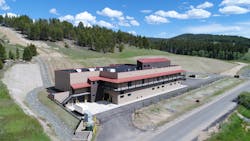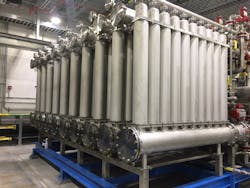Ceramic Membrane System Solves DPB Challenge at Butte-Silver Bow
The Basin Creek Reservoir in Butte, Mont., served its community with pristine water from both sides of the Continental Divide for nearly 100 years. In 2010, a pine beetle infestation killed most of the trees surrounding the reservoir, many of which fell into the water, increasing the natural organic matter (NOM) level. As a result, the Butte-Silver Bow (BSB) Water Utility received a violation notice from the Montana Department of Environmental Quality for exceeding their Maximum Contaminant Limit (MCL) for a certain type of disinfection by-product (DBP). This violation prompted the construction of the Basin Creek Water Treatment Plant (WTP).
In order to maintain the use of the reservoir, filtration needed to be added to reduce the NOM and in turn, the DBPs. Initial efforts focused on site selection, pilot testing, hydraulic analysis, distribution system modeling, and process selection. Based on these initial efforts, a pressurized membrane filtration process was selected and, ultimately, an Aqua MultiBore® C-Series ceramic membrane system was procured by BSB to produce safe and secure drinking water.
The elevation difference between the reservoir and the distribution system allowed the opportunity to use gravity as the driving power to run the filtration plant. The C-series ceramic membrane offers high pressure ratings, allowing BSB to better capitalize on the gravity power. The reservoir pushes water through the membrane and directly into town, so when users in the city turn on their showers or water their lawns, more water flows through the Basin Creek WTP.
“It’s very unique in that it is on-demand, but it is also powered by gravity,” HDR’s project design manager, Nathan Kutil said.
In addition, the Basin Creek WTP was designed to be incredibly efficient; most water treatment plants waste about 10 percent of the water, but this treatment plant wastes less than 0.5 percent of the water it treats — an overall plant recovery of about 99.98 percent.
“It saved a lot of infrastructure cost, and a lot of pumping cost — that was a big advantage of this design,” said Jim Keenan, chief operator of the new plant.
At the 7 MGD design flow, the plant wastes less than 14,000 gallons, very close to zero liquid discharge (ZLD).
“It’s the first ceramic membrane gravity-powered, on-demand plant in the country,” noted Keenan. “We’ve been really pleased with how well the system works and how efficient it is. I really think that we have the most durable, longest-lasting, superior-quality product and I am really excited about that. I think it’s the future of water plants and the example is right here in Butte, Mont.”
Design Characteristics
Butte’s primary membrane system consists of four trains, each with 100 modules arranged in (10) 10-module rows. The backwash water from this system is settled and treated with a backwash recovery train consisting of (2) 6-module rows. For both systems, each row has a complete set of valves such that it operates independently of the other rows; therefore, backwashes and cleanings are performed on one row at a time with the other row(s) in the train remaining in filtration. WWAqua-Aerobic Systems is exhibiting at ACE20, booth 2208. Learn more at www.aqua-aerobic.com

